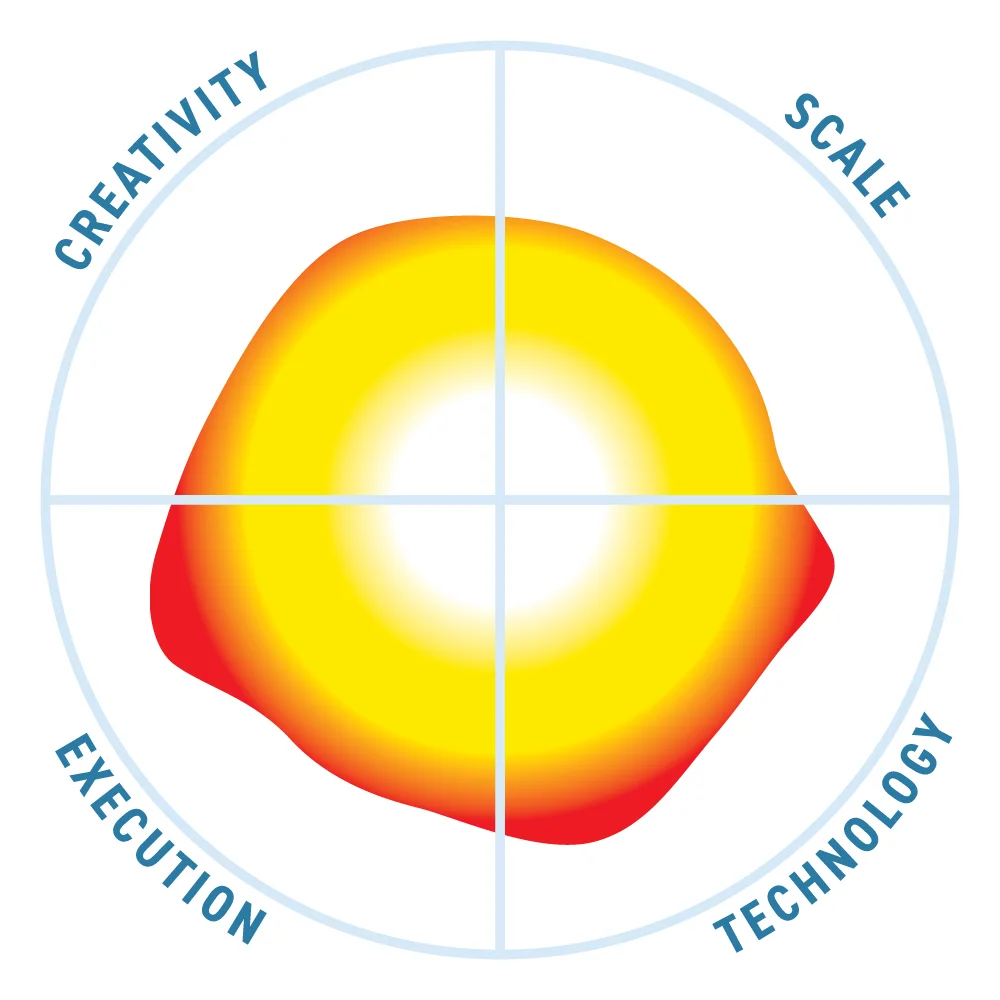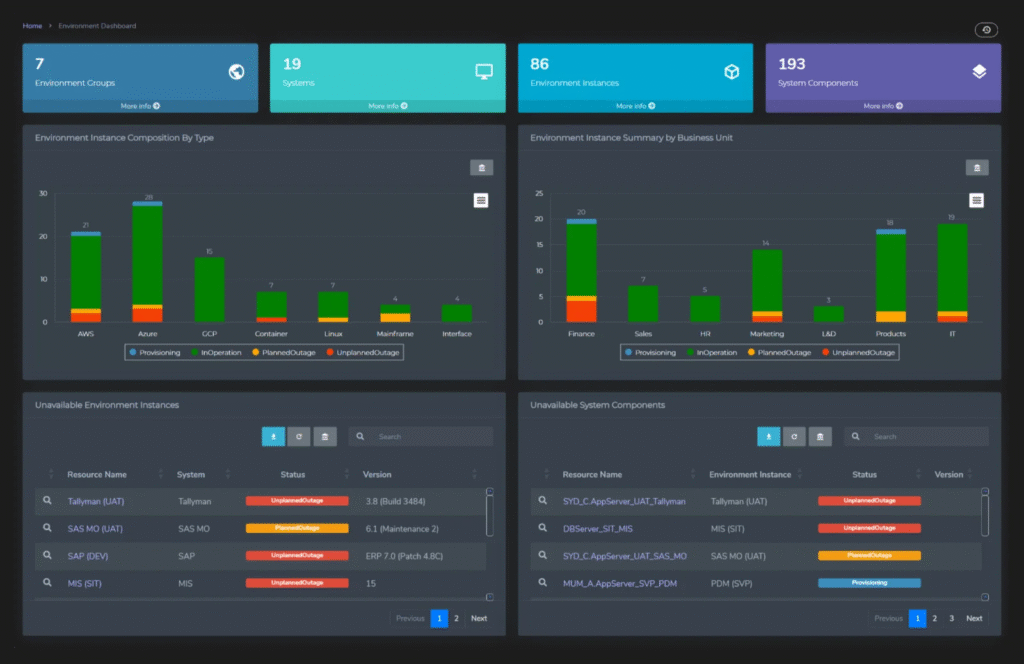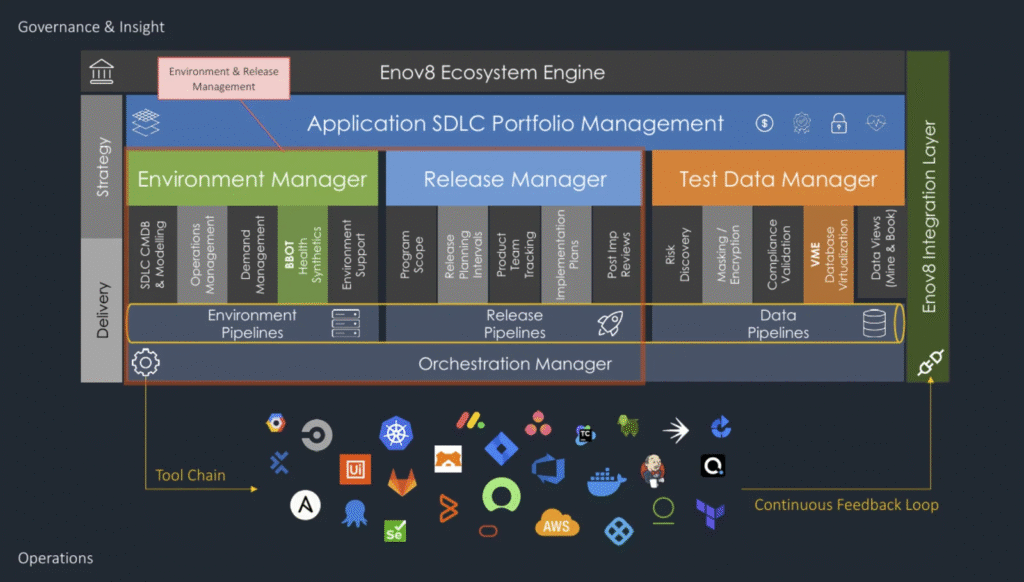Environment Management
Update solution on April 1, 2025

Modern enterprises struggle with fragmented IT environments, slow-release processes, and inefficient test data management. Without a unified approach, organizations face higher costs, compliance risks, and delivery inefficiencies.
Fig 1 – Enov8 Environment Manager, the user interface
Enov8’s Environment Management solution is a key component of its broader IT management platform, with an attractive visual interface (see Figure 1), which also includes Application Portfolio Management, Release Management, and Test Data Management. This forms a complete, proprietary ecosystem with good connectivity to other products, which has real advantages for completeness of coverage – it can support tracking and protection of PII (Personally Identifiable Information), for example, across all of your non-production environments. It might appear more complex than other solutions until you understand its approach and underlying philosophy but, fortunately, Enov8 has good support services and the EMMi, that help you manage continual improvement in the use of the tool. You can start small, simply understanding what you are doing now, and increase the sophistication of your management of your environments as your experience with Enov8 Environment Management grows.

Enov8 Environment Management helps you to:
- Know what environments you have and why you have them.
- Maintain a plan which co-ordinates activities relating to your environments.
- Manage demand and contention for environments.
- Manage and control changes to your environments and track incidents.
- Standardize good practice for operations relating to your environments.
- Implement automated operations as code wherever possible and integrate them with DevOps delivery pipelines.
- Maintain formal deployment and implementation plans.
- Implement real-time analytics, giving you insights into value-stream delivery.
This makes the whole Enov8 ecosystem into a somewhat specialized Configuration Management system (it has a CMDB, Configuration Management Database, for example) which ensures the completeness and integrity of the environments you use for testing. This implies a degree of necessary complexity, but each of the 8 areas listed above are supported out-of-the-box; seamless integration with tools and pipelines you already have is available; and, as we’ve said, comprehensive Enov8 support is offered.
The Enov8 Maturity Model is a structured framework which tracks operational maturity across 8 Key Performance Areas (KPAs) relating to Transparency, Release and Governance:
- Environment Knowledge Management – Understanding IT environments throughout their life cycle, including development, testing, training, and production phases.
- Environment Demand Awareness – Recognizing and managing the needs of environment consumers, such as project and DevTest teams, to ensure optimal resource utilization.
- Environment Planning & Coordination – Proactively organizing environment events and deployments to ensure systems are timely, properly configured, and fit for purpose.
- Environment IT Service Management – Implementing customer-focused IT service delivery and support, including the management of incidents, changes, and releases.
- Application Release Operations – Establishing consistent, repeatable, and traceable application release processes that contribute to effective IT environment management and delivery.
- Data Release & Privacy Operations – Ensuring that data release processes comply with privacy regulations and protect sensitive information.
- Infrastructure & Cloud Release Operations – Managing the deployment and maintenance of infrastructure and cloud resources to support environment needs.
- Status Accounting & Reporting – Maintaining accurate records and reports on environment status to support transparency and informed decision-making.
This should provide a framework for the supply of training beyond just the operation of the tools and should be an excellent basis for managing continual improvement. This does imply, however, that someone in the organization is thinking about the bigger picture – why are you using Enov8 and what will success look like. Enov8 delivers many benefits, but you won’t get them automatically, you will have to put some thought into how you use the tools.
Enov8 Environment Management gives you control of the many environments needed to operate and maintain business automation. Most commonly, these will be test environments – an accurate image of the production environment, usually at a smaller scale, in which you can test new code. Obviously, it is important to be able to set these up efficiently – and, also, to tear them down, in order to release resources. But you also need confidence in them being an accurate copy of production, scaled down, and you’ll need to be able to recreate exactly the same environment whenever you need to.

Fig 2 – Enov8 Environment Manager, the architectural context
Other environments you might need include ones for quality management, for integration testing, for performance management and so on. Enov8 Environment Manager is an integral part of a software platform (see Figure 2, Enov8 Environment Management, the architectural context) that manages Environments, Releases and Test Data. Enov8 Environment Manager’s key capabilities include:
- End-to-end environment management – it provides centralized SDLC (System Development Lifecycle) CMDB and visualization tools, to ensure clear documentation, modeling, and streamlined management of complex environments.
- Architectural blueprinting – it provides system deployment and IT service diagrams to visualize and understand infrastructure, dependencies, and configurations.
- Operations and demand management – it aligns environment availability with business needs, thus reducing bottlenecks and optimizing resource allocation.
- Booking and contention management – it has intelligent scheduling tools, which allow teams to reserve test environments, preventing conflicts and ensuring efficient resource usage.
- Service support and ITSM (IT Service Management) integration – it facilitates centralized management of changes, incidents, and support requests for better operational control and ITSM integration.
- BBOT Health Synthetics – which is a no-code monitoring solution that proactively detects issues across IT environments, improving reliability and reducing test failures (the name derives from worker Bees and automation roBots).
- DevOps orchestration – it automates environment provisioning, health checks, and decommissioning using orchestrated workflows and runbooks.
- Deployment tracking and release visibility – it tracks software versions across environments, ensuring accurate testing and reducing environment drift.
- Test data management – this helps to ensures compliance through data profiling, masking, synthetic data generation, and provisioning, thus allowing secure and efficient test execution.
- Enterprise release management – it provides structured governance for software releases within SAFe (Scaled Agile Framework) and other enterprise frameworks.
- Financial insights and cost optimization – this identifies cost-saving opportunities related to IT over-provisioning, idle resources, and inefficient environment use.
- Being platform and architecture agnostic – Enov8 Environment Management works across any infrastructure, cloud provider, programming language, or platform architecture.
An example is the best way to clarify what Enov8 Environment Management can do overall. Imagine an organization with some 250 people engaged in development testing, 200 environment instances and a Project Budget of $50M pa (per annum). Licensing Enov8 for 200 instances currently costs you US$96k pa (although you also need to consider implementation and training overheads, of course, so the simplified calculation given here is a bit optimistic).
- Enov8 Environment Management helps you to to reduce your footprint. Enov8 analysts estimate that in an un-managed situation you will likely over-provision environments by 20%. If each environment instance costs you about US$75k pa and you save 40 out of 200 environment instances, this is a potential saving of about US$3M pa. Obviously, part of implementing Enov8 Environment Manager is estimating the cost of an environment, and the other costs mentioned below, for your particular organization, so you can document actual cost savings.
- Enov8 Environment Management also increases the productivity of your development testing operation. Enov8 estimates lost productivity at about 5% in an un-managed system. If you employ 250 people for testing at an estimated US$80K pa per person (remember that people cost more than just their salaries), this gives you a potential saving of about US$1M pa.
- Finally, Enov8 Environment Management promises to streamline delivery. If you currently experience delivery delays through operational inefficiencies corresponding to some 2.5% of a US$50M budget, there is another US$1,25M potential saving.
This all adds up to a potential saving of US$5.25M pa for spending US$96k pa on Enov8 licenses. This seems reasonable to us, but only if you operate environment management as a sufficiently mature organization (one that actually achieves any potential payback), so Enov8’s training and consultancy services are important, as is continual improvement against, say, the Enov8 Maturity Model. There is an article offering assistance with ROI (Return on Investment) assessment here.
You should care about the Enov8 Environment Management platform because a failure to manage environments effectively is a major cause of, at best, wasted time and resources and, at worst, of poor quality software that fails in production. You may over-provision environments so as to be sure that one is available when needed. You may be maintaining development environments for legacy systems, for the current status quo, for your next major release and even, sometimes, temporary environments relating to a contingency. Managing all of these manually is time-consuming and error-prone and if you do use the wrong environment for, say, testing or integration, the results can be catastrophic.
You should also care about the availability of the Environment Management Maturity Index (EMMi) because managing environments is a journey, not an absolute. So, you can start small, using the Enov8 Environment Management software platform to manage those aspects of your environments that are giving you immediate issues and then track progress as you mature in each of the core dimensions of the EMMi. This is more achievable and less risky than a “big bang” approach.
The bottom line
The Enov8 Environment Management software platform allows you to manage IT development environments in a holistic and repeatable way, so as to minimize waste. It helps to ensure that the behavior of each of your automated systems is always predictable. By providing advanced visualization capabilities, Enov8 Environment Management ensures clarity and control over even the most complex IT landscapes. Ultimately, it helps you to do more with less, without any nasty surprises.
Related Company
Connect with Us
Ready to Get Started
Learn how Bloor Research can support your organization’s journey toward a smarter, more secure future."
Connect with us Join Our Community
